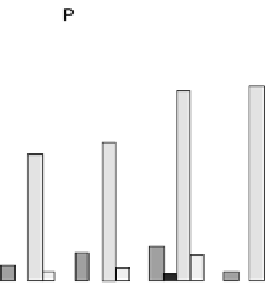Agriculture Reference
In-Depth Information
5.10 NUTRITIONAL VALUES OF CARBOHYDRATE-RICH
ROOT CROPS
Starchy root crops—cassava, yam, potato, and sweet potato—are a major source of
calories for most of the world's population. In some cases they constitute the major
food intake on a daily basis.
As seen in Figure 5.23, cassava has the highest carbohydrate and consequently a
relatively lower content of other nutrients. For this reason cassava is considered to be
a particularly poor source of amino acids and protein. However, all these crops have
low contents of protein, fat, and fiber, although comparatively speaking sweet potato
is the most balanced. Fat is lowest in jicama and potato, being 0.09 and 0.08 percent,
respectively, and highest in taro, 0.74 percent. There is a surprisingly high content of
fiber in sweet potato, considering its other characteristics.
Because of its high carbohydrate content cassava is highest in energy, as seen in
Figure 5.24. The energy content of jicama is lowest, mostly because of its high
water content. Energy content of the other root crops gradually increases from potato
to yam.
In terms of total vitamins root crops are similar except for sweet potato and taro,
which are lower with sweet potato being lowest. Inspite of this sweet potato is signifi-
cantly higher, up to 100 timers higher, in vitamin A than most root crops. Likewise taro
is significantly higher, up to 100 times, in vitamin E than most other root crops.
Figure
5.23.
Nutrient value of root crops. (Data for graph from the Agricultural Research
Service Nutrient Data Laboratory USDA National Nutrient Database for Standard Reference,
Release 17, http:
//
www.nal.usda.gov
/
fnic
/
foodcomp
/
Data
/
SR17
/
reports
/
sr17page.htm.)




















































